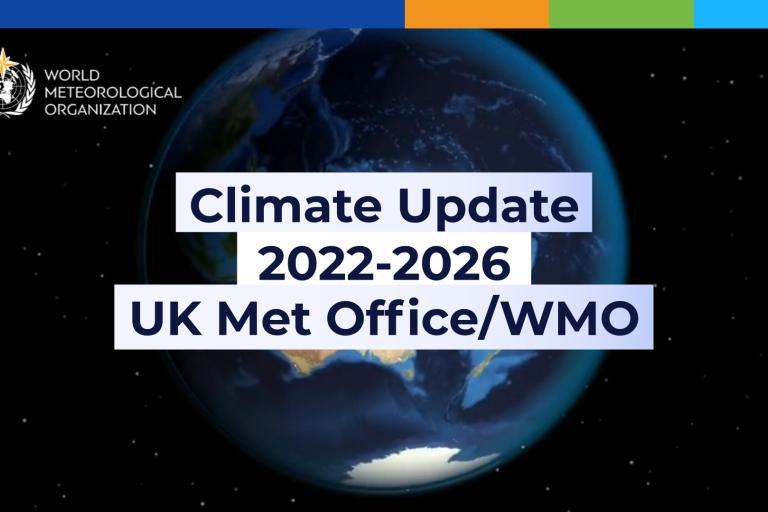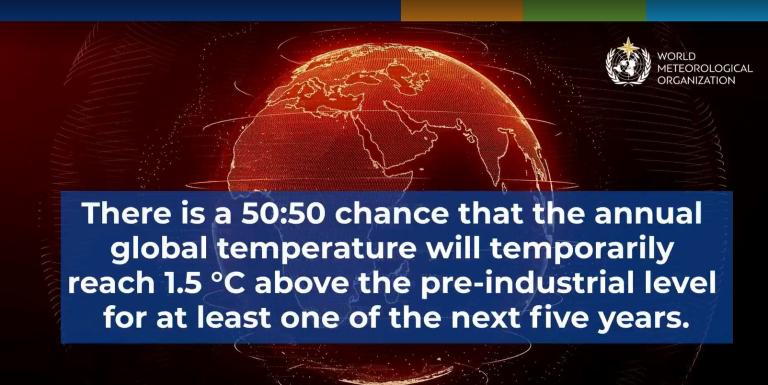WMO update: 50:50 chance of global temperature temporarily reaching 1.5°C threshold in next five years
Geneva, 9 May 2022 (WMO) - There is a 50:50 chance of the annual average global temperature temporarily reaching 1.5 °C above the pre-industrial level for at least one of the next five years – and the likelihood is increasing with time, according to a new climate update issued by the World Meteorological Organization (WMO).

Geneva, 9 May 2022 (WMO) - There is a 50:50 chance of the annual average global temperature temporarily reaching 1.5 °C above the pre-industrial level for at least one of the next five years – and the likelihood is increasing with time, according to a new climate update issued by the World Meteorological Organization (WMO).
There is a 93% likelihood of at least one year between 2022-2026 becoming the warmest on record and dislodging 2016 from the top ranking. The chance of the five-year average for 2022-2026 being higher than the last five years (2017-2021) is also 93%, according to the Global Annual to Decadal Climate Update, produced by the United Kingdom’s Met Office, the WMO lead centre for such predictions.
The annual update harnesses the expertise of internationally acclaimed climate scientists and the best prediction systems from leading climate centres around the world to produce actionable information for decision-makers.
The chance of temporarily exceeding 1.5°C has risen steadily since 2015, when it was close to zero. For the years between 2017 and 2021, there was a 10% chance of exceedance. That probability has increased to nearly 50% for the 2022-2026 period.
“This study shows – with a high level of scientific skill – that we are getting measurably closer to temporarily reaching the lower target of the Paris Agreement on Climate Change. The 1.5°C figure is not some random statistic. It is rather an indicator of the point at which climate impacts will become increasingly harmful for people and indeed the entire planet,” said WMO Secretary-General Prof. Petteri Taalas.
“For as long as we continue to emit greenhouse gases, temperatures will continue to rise. And alongside that, our oceans will continue to become warmer and more acidic, sea ice and glaciers will continue to melt, sea level will continue to rise and our weather will become more extreme. Arctic warming is disproportionately high and what happens in the Arctic affects all of us,” said Prof. Taalas.
The Paris Agreement sets long-term goals to guide all nations to substantially reduce global greenhouse gas emissions to limit the global temperature increase in this century to 2 °C while pursuing efforts to limit the increase even further to 1.5 °C.

The Intergovernmental Panel on Climate Change says that climate-related risks for natural and human systems are higher for global warming of 1.5 °C than at present, but lower than at 2 °C.
Dr Leon Hermanson, of the Met Office led the report. He said: “Our latest climate predictions show that continued global temperature rise will continue, with an even chance that one of the years between 2022 and 2026 will exceed 1.5 °C above pre-industrial levels. A single year of exceedance above 1.5 °C does not mean we have breached the iconic threshold of the Paris Agreement, but it does reveal that we are edging ever closer to a situation where 1.5 °C could be exceeded for an extended period.”
In 2021, the global average temperature was 1.1 °C above the pre-industrial baseline, according to the provisional WMO report on the State of the Global Climate. The final State of the Global Climate report for 2021 will be released on 18 May.
Back-to-back La Niña events at the start and end of 2021 had a cooling effect on global temperatures, but this is only temporary and does not reverse the long-term global warming trend. Any development of an El Niño event would immediately fuel temperatures, as it did in 2016, which is until now the warmest year on record.
The findings of the annual update include:
- The annual mean global near-surface temperature for each year between 2022 and 2026 is predicted to be between 1.1 °C and 1.7 °C higher than preindustrial levels (the average over the years 1850-1900).
- The chance of global near-surface temperature exceeding 1.5 °C above preindustrial levels at least one year between 2022 and 2026 is about as likely as not (48%). There is only a small chance (10%) of the five-year mean exceeding this threshold.
- The chance of at least one year between 2022 and 2026 exceeding the warmest year on record, 2016, is 93%. The chance of the five-year mean for 2022-2026 being higher than the last five years (2017-2021) is also 93%.
- The Arctic temperature anomaly, compared to the 1991-2020 average, is predicted to be more than three times as large as the global mean anomaly when averaged over the next five northern hemisphere extended winters.
- There is no signal for the El Niño Southern Oscillation for December-February 2022/23, but the Southern Oscillation index is predicted to be positive in 2022.
- Predicted precipitation patterns for 2022 compared to the 1991-2020 average suggest an increased chance of drier conditions over southwestern Europe and southwestern North America, and wetter conditions in northern Europe, the Sahel, north-east Brazil, and Australia.
- Predicted precipitation patterns for the May to September 2022-2026 average, compared to the 1991-2020 average, suggest an increased chance of wetter conditions in the Sahel, northern Europe, Alaska and northern Siberia, and drier conditions over the Amazon.
- Predicted precipitation patterns for the November to March 2022/23-2026/27 average, compared to the 1991-2020 average, suggest increased precipitation in the tropics and reduced precipitation in the subtropics, consistent with the patterns expected from climate warming.
Notes for Editors:
With the UK’s Met Office acting as lead centre, climate prediction groups from Spain, Germany, Canada, China, USA, Japan, Australia, Sweden, Norway and Denmark contributed new predictions this year. Combining forecasts from climate prediction centres worldwide enables a higher quality product than what can be obtained from any single source.
The development of near-term prediction capability was driven by the WMO co-sponsored World Climate Research Programme, which declared one of its overarching Grand Challenges is to support research and development to improve multi-year to decadal climate predictions and their utility to decision makers.
Comprehensive Assessment Reports about the state of scientific, technical and socio-economic knowledge on climate change, its impacts and future risks, and options for reducing the rate at which climate change is taking place are the responsibility of the Intergovernmental Panel on Climate Change (IPCC), which also issued a Special Report on Global Warming of 1.5°C.
The World Meteorological Organization (WMO) is a specialized agency of the United Nations responsible for promoting international cooperation in atmospheric science and meteorology.
WMO monitors weather, climate, and water resources and provides support to its Members in forecasting and disaster mitigation. The organization is committed to advancing scientific knowledge and improving public safety and well-being through its work.
For further information, please contact:
- Clare Nullis WMO media officer cnullis@wmo.int +41 79 709 13 97

